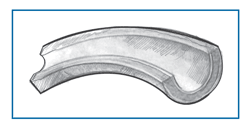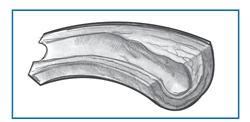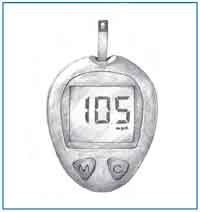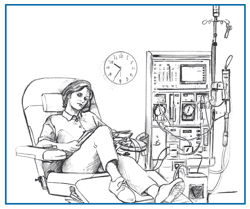
|
|
Other sections: Abbreviations — Commentaries — Diabetes Info — Dictionary — Magazines & Journals — Press Releases — Websites
AA1C (AY-WUHN-SEE): a test that measures a person's average blood glucose level over the past 2 to 3 months. Hemoglobin is the part of a red blood cell that carries oxygen to the cells and sometimes joins with the glucose in the bloodstream. Also called hemoglobin A1C or glycosylated hemoglobin, the test shows the amount of glucose that sticks to the red blood cell, which is proportional to the amount of glucose in the blood. Results are given as a percentage or as an average glucose value, called an estimated average glucose. For more information, see The A1C Test and Diabetes. AADE: American Association of Diabetes Educators. Former name for the
acanthosis nigricans (ak-an-THOH-siss) (NIG-rih-kanz): a skin condition characterized by darkened skin patches; common in people whose body is not responding correctly to the insulin that they make in their pancreas, a condition called insulin resistance. This skin condition is also seen in people who have pre-diabetes or type 2 diabetes. acarbose (A-kahr-bohss): an oral medicine used to treat type 2 diabetes. Acarbose slows down the digestion of foods high in carbohydrate, such as rice, bread, milk, and fruit. The result is a slower and lower rise in blood glucose throughout the day, especially right after meals. Acarbose belongs to the class of medicines called alpha-glucosidase inhibitors. (Brand name: Precose.) For more information, see Alpha-Glucosidase Inhibitors. ACE inhibitor (ayss) (in-HIB-ih-tur): a class of oral medications that lowers blood pressure; ACE stands for angiotensin-converting enzyme. For people with diabetes, especially those who have protein (albumin) in the urine, it also helps slow down kidney damage. acesulfame potassium (AY-see-SUHL-faym) (poh-TASS-ee-uhm): a dietary sweetener with no calories and no nutritional value. Also known as acesulfame-K. (Brand name: Sunett.) Actoplus Met (AK-toh-pluhss) (met): the brand name of an oral medicine used to treat type 2 diabetes; a combination of pioglitazone and metformin. For more information, see Combination Diabetes Pills. Actos (AK-tohss): the brand name of an oral medicine used to treat type 2 diabetes, pioglitazone. For more information, see Thiazolidinediones. acute (uh-KYOOT): describes something that happens suddenly and for a short time. Opposite of chronic, or long lasting. acute renal failure (uh-KYOOT) (REE-nuhl) (FAYL-yoor): sudden and temporary loss of kidney function. See chronic kidney disease. adhesive capsulitis (ad-HEE-siv) (KAP-soo-LY-tiss): a condition of the shoulder associated with diabetes that results in pain and loss of the ability to move the shoulder in all directions. Also called frozen shoulder. adult-onset diabetes (uh-DUHLT-AWN-set) (DY-uh-BEE-teez): former term for type 2 diabetes. AGEs (AY-JEE-EEZ): stands for advanced glycosylation end products. AGEs are produced in the body when glucose links with protein. They play a role in damaging blood vessels, which can lead to diabetes complications. albumin (al-BYOO-min): the main protein in blood. Over several years, people who are developing diabetic kidney disease leak small amounts of albumin into the urine, a condition called microalbuminuria. As kidney disease progresses, more albumin leaks into the urine, a condition called macroalbuminuria or proteinuria. As the amount of albumin in the urine increases, the kidneys' ability to filter the blood decreases. albuminuria (al-BYOO-min-YOO-ree-uh): a condition in which the urine has more than normal amounts of a protein called albumin. Albuminuria may be a sign of nephropathy, or kidney disease. See albumin. alpha cell (AL-fuh) (sel): a type of cell in the islets of Langerhans within the pancreas. Alpha cells make and release a hormone called glucagon. The body sends a signal to the alpha cells to make glucagon when blood glucose falls too low. Then glucagon reaches the liver where it tells the liver to release glucose into the blood for energy. alpha-glucosidase inhibitor (AL-fuh-gloo-KOH-sih-dayss) (in-HIB-ih-tur): a class of oral medicine for type 2 diabetes that slows down the digestion of foods high in carbohydrate, such as rice, bread, milk, and fruit. The result is a slower and lower rise in blood glucose after meals. (Generic names/Brand names: acarbose/Precose; miglitol/Glyset.) For more information, see Alpha-Glucosidase Inhibitors. alternative site testing: using areas of the body other than the fingertips for blood glucose monitoring. Amaryl (AM-uh-ril): the brand name of an oral medicine used to treat type 2 diabetes, glimepiride. For more information, see Sulfonylureas.
amputate (AM-pyoo-tayt): to cut a part, such as a foot, from the body. amylin (AM-ih-lin): a hormone formed by beta cells in the pancreas. Amylin regulates the timing of glucose release into the bloodstream after eating by slowing the emptying of the stomach. amylin mimetic (AM-ih-lin) (mih-MET-ik): a type of injectable medicine for diabetes that mimics the effect of the hormone amylin. This medicine helps food move more slowly through the stomach and helps keep the liver from releasing stored glucose. (Generic name/Brand name: pramlintide acetate/ Symlin. For more information, see Amylin Mimetic.) amyotrophy (uh-my-OT-roh-fee): a type of neuropathy resulting in pain, weakness, or wasting in the muscles. anemia (uh-NEE-mee-uh): a condition in which the number of red blood cells is less than normal, resulting in less oxygen being carried to the body's cells. Anemia can cause extreme fatigue. angina (ANN-gin-ah or ann-JI-nah): A squeezing pain or pressure sensation in the chest, usually due to atherosclerosis of the blood vessels of the heart. For more information, see How will I know whether I have heart disease? angiopathy (AN-jee-OP-uh-thee): any disease of the blood vessels (arteries, capillaries, veins) or lymphatic vessels. antibodies (AN-tee-BOD-eez): proteins made by the body to protect itself from foreign substances such as bacteria or viruses. People get type 1 diabetes when their bodies make antibodies that destroy the body's own insulin-making beta cells. Apidra (uh-PEE-druh): the brand name of a a form of insulin, insulin glulisine. For more information, see Types of Insulin.) ARB (arb): a class of oral medications that lowers blood pressure. ARB stands for angiotensin receptor blocker. For people with diabetes, especially those who have protein (albumin) in the urine, it also helps slow down kidney damage. arteriosclerosis (ar-TIHR-ee-oh-sklur-OH-siss): see atherosclerosis. artery (AR-tur-ee): a large blood vessel that carries blood with oxygen from the heart to all parts of the body. aspartame (ASS-par-taym): a dietary sweetener with almost no calories and no nutritional value. It was first sold under the brand name NutraSweet; since 2009 it also has been sold under other brand names. atherosclerosis (ATH-ur-oh-sklur-OH-siss): clogging, narrowing, and hardening of the body's large blood vessels, also called arteries. Atherosclerosis can lead to coronary heart disease, heart attacks, peripheral arterial disease, strokes, and transient ischemic attacks. It can also damage the arteries that go to the kidneys.
athlete's foot (ATH-leets) (fut): a fungal infection of the skin on the foot, also called tinea pedis. The fungus is common in people with diabetes, the elderly, and people with an impaired immune system. The skin may peel, crack, bleed, or cause pain. Some people have no symptoms and do not know they have an infection. The affected skin is also more vulnerable to bacteria that cause cellulitis. Common Types of Athlete's Foot
autoantibody (AW-toh AN-tee-BOD-ee): An antibody (a type of protein) manufactured by the immune system that is directed against one or more of the individual's own proteins. See antibodies
autoimmune disease (AW-toh-ih-MYOON) (dih-ZEEZ): a disorder of the body's immune system in which the immune system mistakenly attacks and destroys body tissue that it believes to be foreign. autonomic neuropathy (AW-toh-NOM-ik) (noo-ROP-uh-thee): a type of neuropathy affecting the lungs, heart, stomach, intestines, bladder, or genitals. Avandamet (uh-VAN-duh-met): the brand name of an oral medicine used to treat type 2 diabetes; a combination of rosiglitazone and metformin. For more information, see Combination Diabetes Pills. Avandaryl (uh-VAN-duh-ril): the brand name of an oral medicine used to treat type 2 diabetes; a combination of rosiglitazone and glimepiride. For more information, see Combination Diabetes Pills. Avandia (uh-VAN-dee-uh): the brand name of an oral medicine used to treat type 2 diabetes, rosiglitazone. For more information, see Thiazolidinediones. 
Bbackground retinopathy (BAK-ground) (RET-ih-NOP-uh-thee): a type of damage to the retina of the eye marked by bleeding, fluid accumulation, and abnormal dilation of the blood vessels. Background retinopathy is an early stage of diabetic retinopathy. Also called simple or nonproliferative retinopathy. basal rate (BAY-suhl) (rayt): a continuous supply of low levels of longer-acting insulin, as used in insulin pump. beta cell (BAY-tuh) (sel): a cell that makes insulin. Beta cells are located in the islets of Langerhans within the pancreas. biguanide (by-GWAH-nyd): a class of oral medicine used to treat type 2 diabetes that lowers blood glucose by reducing the amount of glucose produced by the liver. This type of medicine also helps treat insulin resistance, a condition in which the body doesn't use insulin the way it should. (Generic names/Brand names: metformin/Glucophage, Glucophage XR, Riomet.) For more information, see Biguanides. blood glucose (bluhd) (GLOO-kohss): the main sugar found in the blood and the body's main source of energy. Also called blood sugar. blood glucose level (bluhd) (GLOO-kohss) (LEV-uhl):
the amount of glucose in a given amount of blood.
In the United States, blood glucose levels are noted in milligrams per deciliter, or mg/dL.
In the rest of the world, blood glucose levels are noted in millimoles per liter, or mmol/L.
The approximate calculation rule for conversion of mg/dl in mmol/l and vice versa is:
blood glucose meter (bluhd) (GLOO-kohss) (MEE-tur): a small, portable machine used by people with diabetes to check their blood glucose levels. After pricking the skin with a lancet, one places a drop of blood on a test strip in the machine. The meter then displays the blood glucose reading.
blood glucose monitoring (bluhd) (GLOO-kohss) (MON-ih-TUR-ing): checking blood glucose levels by using a blood glucose meter or blood glucose test strips that change color when touched by a blood sample in order to manage diabetes. blood pressure: the force of blood exerted on the inside walls of blood vessels. Blood pressure is expressed as two numbers. For example, a blood pressure result of 120/80 is said as "120 over 80." The first number is the systolic pressure, or the pressure when the heart pushes blood into the arteries. The second number is the diastolic pressure, or the pressure when the heart rests. blood sugar: see blood glucose. blood sugar level: see blood glucose level. blood urea nitrogen (BUN) (bluhd) (yoo-REE-uh) (NY-troh-jen): a waste product in the blood from the breakdown of protein. The kidneys filter blood to remove urea. As kidney function decreases, the BUN level increases. blood vessels (bluhd) (VESS-uhlz): tubes that carry blood to and from all parts of the body. The three main types of blood vessels are arteries, capillaries, and veins. BMI: body mass index.
body mass index (BMI): a measure used to evaluate body weight relative to a person's height. BMI is used to find out if a person is underweight, normal weight, overweight, or obese. For more information, see BMI. body tissue: a group of cells in the body that performs a specific function. bolus (BOH-luhss): an extra amount of insulin taken to cover an expected rise in blood glucose, often related to a meal or snack. borderline diabetes (BOR-dur-lyn) (DY-uh-BEE-teez): a former term for type 2 diabetes or pre-diabetes. brittle diabetes (BRIH-tuhl) (DY-uh-BEE-teez): a term used when a person's blood glucose level moves often from low to high and from high to low. bromocriptine: an oral medicine used to treat type 2 diabetes. Brand name: Cycloset. For more information, see Other Diabetes Medications. BUN (BEE-YOO-EN): see blood urea nitrogen. bunion (BUHN-yuhn): a bulge on the first joint of the big toe, caused by the swelling of a fluid sac under the skin. This spot can become red, sore, and infected. Byetta (by-YAY-tuh): the brand name of an injectible medicine used to treat type 2 diabetes, exenatide. For more information, see Incretin Mimetics. 
Ccallus (KAL-uhss): a small area of skin, usually on the foot, that has become thick and hard from rubbing or pressure.calorie: a unit representing the energy provided by food. Carbohydrate, protein, fat, and alcohol provide calories in the diet. Carbohydrate and protein have 4 calories per gram, fat has 9 calories per gram, and alcohol has 7 calories per gram. Candida (KAN-did-uh): a fungus that is normally found in the body but commonly becomes overgrown in people with diabetes. Overgrowth is due to increased sugar in the body and a weakened immune system. Use of antibiotics or birth control pills also increases the risk of candida overgrowth. Candida overgrowth can lead to infection, causing itching, skin lesions, or rash. Some common areas of infection are in or around the mouth, armpits, groin, vagina, and nails. CAPD (SEE-AY-PEE-DEE): see continuous ambulatory peritoneal dialysis under dialysis. capillary (KAP-ih-lair-ee): the smallest of the body's blood vessels. Oxygen and glucose pass through capillary walls and enter the cells. Waste products such as carbon dioxide pass back from the cells into the blood through capillaries. capsaicin (kap-SAY-ih-sin): an ingredient in hot peppers that can be found in ointment form for use on the skin to relieve pain from diabetic neuropathy. carbohydrate (KAR-boh-HY-drayt): one of the three main nutrients in food. Foods that provide carbohydrate are starches, vegetables, fruits, dairy products, and sugars.
carbohydrate counting (KAR-boh-HY-drayt) (KOUN-ting): a method of meal planning for people with diabetes based on counting the number of grams of carbohydrate in food. carbohydrate ratio: see insulin-to-carb ratio. cardiologist (KAR-dee-OL-oh-jist): a doctor who treats people who have heart problems. cardiovascular disease (KAR-dee-oh-VASS-kyoo-lur) (dih-ZEEZ): disease of the heart and blood vessels (arteries, capillaries, and veins). carpal tunnel syndrome (KAR-puhl) (TUHN-uhl) (SIN-drohm): a common form of neuropathy occurring with diabetes. Symptoms of carpal tunnel syndrome include nighttime hand tingling and pain and numbness and weakness in the hand and wrist that sometimes radiates up the arm. Carpal tunnel syndrome often affects both wrists and occurs more often in women than men. cataract (KAT-uh-rakt): clouding of the lens of the eye. CCPD: see continuous cycling peritoneal dialysis under dialysis. CDE: see certified diabetes educator. celiac disease (SEE-lee-ak) (dih-ZEEZ): the inability to digest and absorb proteins called gluten found in wheat, rye, and barley. Celiac disease causes damage to the lining of the small intestine and prevents absorption of nutrients. Also called celiac sprue, gluten intolerance, and nontropical sprue. cellulitis (SEL-yoo-LY-tiss): a skin infection caused by bacteria that gets into the skin through a wound. Cellulitis may develop from skin problems such as ulcers, eczema, psoriasis, or a fungal infection like athlete's foot. People with diabetes, peripheral arterial disease, or a weakened immune system may develop cellulitis. If not treated with antibiotics, the infection can spread to the blood or lymph nodes and cause death. cerebral vascular disease (seh-REE-bruhl) (VASS-kyoo-lur) (dih-ZEEZ): damage to blood vessels in the brain. Vessels can burst and bleed or become clogged with fatty deposits. A stroke results when blood flow is interrupted and brain cells die or are damaged. certified diabetes educator (CDE) (SER-tih-fyd) (DY-uh-BEE-teez) (EH-juh-KAY-tur): a health care professional with expertise in diabetes education who has met eligibility requirements and successfully completed a certification exam. See diabetes educator. CGM / CGMS: see continuous glucose monitoring / continuous glucose monitoring system. Charcot's foot (SHAHR-kohz) (fut): a condition resulting from nerve damage in which the joints and soft tissue in the foot are destroyed. cheiroarthropathy (KY-roh-ar-THROP-uh-thee): see limited joint mobility. cheiropathy (ky-ROP-uh-thee): see limited joint mobility. chlorpropamide (klor-PROH-puh-myd): an oral medicine used to treat type 2 diabetes. Chlorpropamide lowers blood glucose levels by helping the pancreas make more insulin and by helping the body better use the insulin it makes. Chlorpropamide belongs to the class of medicines called sulfonylureas. (Brand name: Diabinese.) For more information, see Sulfonylureas. cholesterol (koh-LESS-tur-ol): a type of fat produced by the liver and found in the blood. Cholesterol is also found in some foods. The body uses cholesterol to make hormones and build cell walls. For more information, see What You Need To Know About High Blood Cholesterol. chronic (KRON-ik): describes something that is long-lasting. Opposite of acute. chronic kidney disease (CKD) (KRON-ik) (KID-nee) (dih-ZEEZ): any condition that causes reduced kidney function over a period of time. CKD is present when a patient's glomerular filtration rate remains below 60 milliliters per minute for more than 3 months. CKD may develop over many years and lead to end-stage renal disease. For more information, see Kidney Disease of Diabetes. circulation (SUR-kyoo-LAY-shuhn): the flow of blood through the body's blood vessels and heart. CKD: chronic kidney disease. claudication (CLAW-dih-KAY-shuhn): see intermittent claudication. coma (KOH-muh): a sleeplike state in which a person is not conscious. In people with diabetes, a coma might be caused by either hyperglycemia (high blood glucose) or hypoglycemia (low blood glucose), as well as other reasons. combination diabetes pill (KOM-bih-NAY-shuhn) (DY-uh-BEE-teez) (pil): a pill that includes two or more different medicines for the treatment of diabetes. For more information, see Combination Diabetes Pills. colesevelam: an oral medicine used to treat type 2 diabetes. Brand name: Welchol. For more information, see Other Diabetes Medications. combination therapy: the use of different medicines together to manage blood glucose levels. complications (KOM-plih-KAY-shuhnz): harmful effects of diabetes such as damage to the eyes, heart, blood vessels, nervous system, teeth and gums, feet and skin, or kidneys. Studies show that keeping blood glucose, blood pressure, and LDL cholesterol levels close to normal can help prevent or delay these problems. congenital defects (kon-JEN-ih-tuhl) (DEE-fekts): problems or conditions that are present at birth. congestive heart failure (kon-JESS-tiv) (hart) (FAYL-yoor): the type of heart failure in which loss of the heart's pumping power causes fluid to build up in the body. constipation (KON-stih-PAY-shuhn): a condition in which the stool becomes hard and dry. A person who is constipated usually has fewer than three bowel movements in a week. Bowel movements may be painful. continuous ambulatory peritoneal dialysis (kon-TIN-yoo-uhss) (AM-byoo-luh-TOR-ee) (PAIR-ih-toh-NEE-uhl) (dy-AL-ih-siss): see continuous ambulatory peritoneal dialysis under dialysis. continuous cycling peritoneal dialysis (kon-TIN-yoo-uhss) (SY-kling) (PAIR-ih-toh-NEE-uhl) (dy-AL-ih-siss): see continuous cycling peritoneal dialysis under dialysis. continuous glucose monitoring / continuous glucose monitoring system (CGM/CGMS) (kon-TIN-yoo-uhss) (GLOO-kohss) (MON-ih-TUR-ing) (SISS-tuhm): a device that includes a small sensor inserted below the skin and a receiver unit, that measures blood glucose levels every few minutes. For more information, see Continuous Glucose Monitoring. continuous subcutaneous insulin injection (CSII) (kon-TIN-yoo-uhss) (SUHB-kyoo-TAY-nee-uhss) (IN-suh-lin) (in-JEK-shuhn): see insulin pump. conventional therapy: a term used in clinical trials where one group receives treatment for diabetes in which A1C and blood glucose levels are kept at levels based on current practice guidelines. However, the goal is not to keep blood glucose levels as close to normal as possible, as is done in intensive therapy. Conventional therapy includes use of medication, meal planning, and exercise, along with regular visits to health care providers. correction bolus: the amount of insulin estimated to be needed to return a high blood glucose level into the target range. This term is used primarily with insulin pumps. coronary artery disease (KOR-uh-nair-ee) (AR-tur-ee) (dih-ZEEZ): see coronary heart disease. coronary heart disease (KOR-uh-nair-ee) (hart) (dih-ZEEZ): heart disease caused by narrowing of the arteries that supply blood to the heart. If the blood supply is cut off the result is a heart attack. C-peptide (SEE-PEP-tyd): a substance the pancreas releases into the bloodstream in equal amounts to insulin. A test of C-peptide levels shows how much insulin the body is making. C-reactive protein (SEE-ree-AK-tiv) (PROH-teen): a substance produced in the liver in response to injury or inflammation. Elevated levels of C-reactive protein are associated with a higher risk of heart attack and stroke. creatinine (kree-AT-ih-neen): a waste product from meat protein in the diet and from the muscles of the body. Creatinine is removed from the body by the kidneys; as kidney disease progresses, the level of creatinine in the blood increases. creatinine clearance (kree-AT-ih-neen) (KLIHR-ants): a test that measures how efficiently the kidneys remove creatinine and other wastes from the blood. Low creatinine clearance indicates impaired kidney function. CSII (continuous subcutaneous insulin injection) (SEE-ESS-EYE-EYE): see insulin pump. Cycloset: the brand name of an oral medicine used to treat type 2 diabetes, bromocriptine. For more information, see Other Diabetes Medications. 
Ddawn phenomenon (dawn) (fuh-NOM-uh-non): the early-morning (4 a.m. to 8 a.m.) rise in blood glucose.DBlog (DEE-blog): A website at which an individual or individuals record opinions, information, and gossip about living with diabetes. DCCT: see Diabetes Control and Complications Trial. debridement (day-breed-MAW): removal of dead or infected tissue from a wound. Debridement can be done with enzymes; mechanically, such as in a whirlpool; or through surgery. dehydration (dee-hy-DRAY-shuhn): the loss of too much body fluid through frequent urinating, sweating, diarrhea, or vomiting. dermopathy (dur-MOP-uh-thee): disease of the skin. dextrose (DEKS-trohss): simple sugar found in blood that serves as the body's main source of energy. Also called glucose. DiaBeta (dy-uh-BAY-tuh): the brand name of an oral medicine used to treat type 2 diabetes, glyburide. For more information, see Sulfonylureas. diabetes (DY-uh-BEE-teez): a condition characterized by hyperglycemia (high blood glucose) resulting from the body's inability to use blood glucose for energy. More correctly called diabetes mellitus. In type 1 diabetes, the pancreas no longer makes insulin; therefore, blood glucose cannot enter the cells to be used for energy. In type 2 diabetes, either the pancreas does not make enough insulin or the body is unable to use insulin correctly. Diabetes Control and Complications Trial (DCCT) (DY-uh-BEE-teez) (kon-TROHL) (and) (KOM-plih-KAY-shuhnz) (TRY-uhl): a study by the National Institute of Diabetes and Digestive and Kidney Diseases, conducted from 1983 to 1993 in people with type 1 diabetes. The study showed that intensive therapy compared with conventional therapy significantly helped prevent or delay diabetic retinopathy, kidney disease, and nerve disease. Intensive therapy included multiple daily injections of insulin or the use of an insulin pump with multiple blood glucose readings each day. For more information, see The Diabetes Control and Complications Trial and Follow-up Study. diabetes educator (DY-uh-BEE-teez) (EH-juh-KAY-tur): a health care professional who teaches people who have diabetes how to manage their condition. Some diabetes educators are certified diabetes educators (CDEs). Diabetes educators are found in hospitals, physician offices, managed care organizations, home health care, and other settings. diabetes insipidus (DY-uh-BEE-teez) (in-SIH-puh-duhss): a condition characterized by frequent and heavy urination, excessive thirst, and an overall feeling of weakness. This condition may be caused by a defect in the pituitary gland or in the kidney. In diabetes insipidus, blood glucose levels are normal. diabetes mellitus (DY-uh-BEE-teez) (MEH-luh-tuhss): see diabetes. Diabetes Prevention Program (DPP) (DY-uh-BEE-teez) (pree-VEN-shuhn) (PROH-gram): a study by the National Institute of Diabetes and Digestive and Kidney Diseases conducted from 1998 to 2001 in people at high risk for type 2 diabetes. All study participants had impaired glucose tolerance, also called pre-diabetes, and were overweight. The study showed that people who lost 5 to 7 percent of their body weight through a low-fat, low-calorie diet and moderate physical activity-usually walking for 30 minutes 5 days a week-reduced their risk of getting type 2 diabetes by 58 percent. Participants who received treatment with the oral diabetes drug metformin reduced their risk of getting type 2 diabetes by 31 percent. For more information, see Diabetes Prevention Program. diabetes self-management (DY-uh-BEE-teez) (self-MAN-uhj-ment): see self-management. diabetic diarrhea (DY-uh-BET-ik) (DY-uh-REE-uh): loose stools, fecal incontinence, or both that result from an overgrowth of bacteria in the small intestine and diabetic neuropathy in the intestines. This nerve damage can also result in constipation. diabetic eye disease (DY-uh-BET-ik) (eye) (dih-ZEEZ): see diabetic retinopathy. diabetic gastropathy (DY-uh-BET-ik) (gass-TROP-uh-thee): see gastropathy. diabetic ketoacidosis (DKA) (DY-uh-BET-ik) (KEE-toh-ASS-ih-DOH-siss): an emergency condition in which extremely high blood glucose levels, along with a severe lack of insulin, result in the breakdown of body fat for energy and an accumulation of ketones in the blood and urine. Signs of DKA are nausea and vomiting, stomach pain, fruity breath odor, and rapid breathing. Untreated DKA can lead to coma and death. diabetic myelopathy (DY-uh-BET-ik) (MY-uh-LOP-uh-thee): damage to the spinal cord found in some people with diabetes. diabetic nephropathy (DY-uh-BET-ik) (neh-FROP-uh-thee): see nephropathy. diabetic neuropathy (DY-uh-BET-ik) (noo-ROP-uh-thee): see neuropathy. diabetic retinopathy (DY-uh-BET-ik) (RET-ih-NOP-uh-thee): damage to the small blood vessels in the retina. Loss of vision may result. Also called diabetic eye disease. diabetogenic (DY-uh-BET-oh-JEN-ik): causing diabetes. For example, some drugs cause blood glucose levels to rise, resulting in diabetes. diabetologist (DY-uh-beh-TOL-uh-jist): a doctor who specializes in treating people who have diabetes. Diabinese (dy-AB-ih-neez): the brand name of an oral medicine used to treat type 2 diabetes, chlorpropamide. For more information, see Sulfonylureas. diabulimia (DYE-uh-boo-LEEEM-ee-ahh): an extreme weight loss method practiced by some people with type 1 diabetes, who deliberately reduce or completely skip required daily insulin shots in order to induce rapid weight loss. For more information, see The Dangers of Diabulimia. diagnosis (DY-ag-NOH-siss): the determination of a disease from its signs and symptoms. dialysis (dy-AL-ih-siss): the process of cleaning wastes from the blood artificially. This job is normally done by the kidneys. If the kidneys fail, the blood must be cleaned artificially with special equipment. The two major forms of dialysis are hemodialysis and peritoneal dialysis.
dialysis solution (dy-AL-ih-siss) (suh-LOO-shuhn): a cleansing liquid used in the two major forms of dialysis-hemodialysis and peritoneal dialysis. Dialysis solution contains dextrose, a sugar, and other chemicals similar to those in the body. Dextrose draws wastes and extra fluid from the body into the dialysis solution. diastolic pressure (DY-uh-STOL-ik) (PRESH-ur): the blood pressure when the heart rests. dietitian (DY-uh-TISH-uhn): a health care professional who advises people about meal planning, weight control, and diabetes management. A registered dietitian (RD) has met certain requirements. dilated eye exam (DY-lay-ted) (eye) (ek-ZAM): a test done by an eye care specialist in which the pupil-the black center-of the eye is temporarily enlarged with eyedrops to allow the specialist to see the inside of the eye more easily.
dipeptidyl peptidase-4 inhibitor (dy-PEP-tih-dil) (PEP-tih-dayss-FOR) (in-HIB-ih-tur): see DPP-4 inhibitor. DKA: diabetic ketoacidosis. D-phenylalanine derivative (DEE-FEN-il-AL-uh-neen) (duh-RIV-uh-tiv): a type of oral medicine for type 2 diabetes that lowers blood glucose levels by helping the pancreas make more insulin right after meals. (Generic name/Brand name: nateglinide/Starlix.) For more information, see D-Phenylalanine Derivative. DPP: see Diabetes Prevention Program. DPP-4 inhibitor (DEE-PEE-PEE-FOR) (in-HIB-ih-tur): a class of oral medicine used to treat type 2 diabetes that lowers blood glucose by helping the body make more insulin when it's needed. This type of medicine also helps keep the liver from putting stored blood glucose into the blood. (Generic names/Brand names: sitagliptin phosphate/Januvia, vildagliptin/Galvus, saxagliptin/Onglyza, linagliptin/Trajenta.) For more information, see DPP-4 Inhibitors. Duetact (DOO-uh-tak): the brand name of an oral combination medicine used to treat type 2 diabetes; a combination of pioglitazone and glimepiride. For more information, see Combination Diabetes Pills. Dupuytren's contracture (doo-pwee-TRENZ) (kon-TRAK-chur): a condition associated with diabetes in which the fingers and the palm of the hand thicken and shorten, causing the fingers to curve inward. duration: in referring to insulin, the length of time during which insulin keeps lowering blood glucose levels. Duration may also refer to the length of time a person has had diabetes, which determines a person's risk of developing diabetes complications. 
Diabetes Dictionary: A B C D E F G H I J K L M N O P Q R S T U V W X Y Z
Modified from
the dictionary at the
National Diabetes Information
Clearinghouse
|
|||||||||||||||||||||||||



















